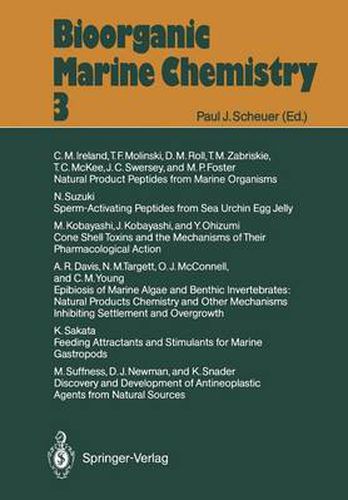Readings Newsletter
Become a Readings Member to make your shopping experience even easier.
Sign in or sign up for free!
You’re not far away from qualifying for FREE standard shipping within Australia
You’ve qualified for FREE standard shipping within Australia
The cart is loading…






This title is printed to order. This book may have been self-published. If so, we cannot guarantee the quality of the content. In the main most books will have gone through the editing process however some may not. We therefore suggest that you be aware of this before ordering this book. If in doubt check either the author or publisher’s details as we are unable to accept any returns unless they are faulty. Please contact us if you have any questions.
The first three chapters of Vol. 3 of Bio-organic Marine Chemistry deal with the chemistry and function of peptides. Chapter 1 by Ireland and coworkers serves as an introduction to marine-derived peptides. It is arranged phyletically and encompasses the entire range from dipeptides to a compound with 95 amino acid residues. Peptides involved in primary metabolism and hence belonging to the realm of macromolecular biochemistry are excluded. However, it might be mentioned in passing that the dividing line between large and small molecule chemistry is continually becoming less distinct. Not only are more compounds of intermediate size, from 1,000 to 10,000 dalton, being discovered, but instruments and techniques, particularly in mass spectrometry and nuclear magnetic resonance have been developed for their structural elucidation by what is considered small molecule methodology. Two groups of peptides are discussed in separate chapters. Biologists who have observed and described the mating behavior of diverse species of marine invertebrates have long surmised that a chemical mechanism might be operating in many cases of individual as well as mass fertilization. The chemical activators of sea urchin sperm prove to be a series of peptides, whose structures and activity are discussed by Suzuki.
$9.00 standard shipping within Australia
FREE standard shipping within Australia for orders over $100.00
Express & International shipping calculated at checkout
This title is printed to order. This book may have been self-published. If so, we cannot guarantee the quality of the content. In the main most books will have gone through the editing process however some may not. We therefore suggest that you be aware of this before ordering this book. If in doubt check either the author or publisher’s details as we are unable to accept any returns unless they are faulty. Please contact us if you have any questions.
The first three chapters of Vol. 3 of Bio-organic Marine Chemistry deal with the chemistry and function of peptides. Chapter 1 by Ireland and coworkers serves as an introduction to marine-derived peptides. It is arranged phyletically and encompasses the entire range from dipeptides to a compound with 95 amino acid residues. Peptides involved in primary metabolism and hence belonging to the realm of macromolecular biochemistry are excluded. However, it might be mentioned in passing that the dividing line between large and small molecule chemistry is continually becoming less distinct. Not only are more compounds of intermediate size, from 1,000 to 10,000 dalton, being discovered, but instruments and techniques, particularly in mass spectrometry and nuclear magnetic resonance have been developed for their structural elucidation by what is considered small molecule methodology. Two groups of peptides are discussed in separate chapters. Biologists who have observed and described the mating behavior of diverse species of marine invertebrates have long surmised that a chemical mechanism might be operating in many cases of individual as well as mass fertilization. The chemical activators of sea urchin sperm prove to be a series of peptides, whose structures and activity are discussed by Suzuki.